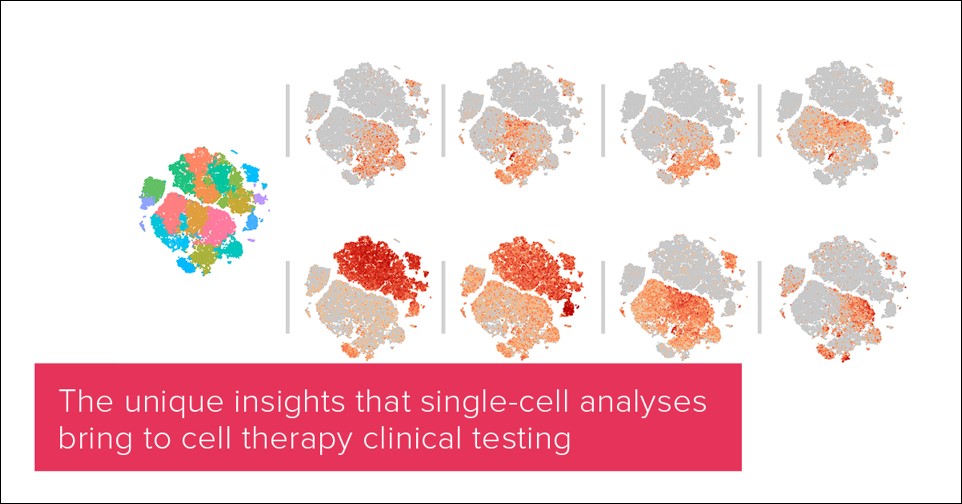October 10, 2024

The landscape of cell therapy targets and approaches is rapidly expanding and diversifying. As a result, clinical testing is evolving. Testing programs must characterize increasingly complex and varied cell products in a quest to usher novel treatments from development through clinical approval.
Our Cell Therapy Trends Report explores this adaptation to accurately evaluate next-generation cell therapies while meeting budget and time constraints. With sights on emerging methods, it describes the notable role of single-cell analysis in unlocking efficacy and adverse events prediction. Here, we describe the recent progression of single-cell analyses and why they are needed to advance cell therapies.
“Single-cell” comes into its own
For 400 years, since the birth of the microscope, scientists have been studying the behavior of individual cells to understand how organisms function. In recent years, technology for single-cell analysis has exploded.
Fluorescence microscopy was pioneered in 1904, flow-based coulter counting in 1954, and fluorescent flow cytometry in 1968. While just two fluorescent dyes were available in the 1970s, by the early 2000s dozens of dyes enabled measurement of 20 proteins per cell over millions of cells.
The next two decades brought mass cytometry, followed by spectral flow cytometry, expanding to 40+ proteins per cell. With the debut of single-cell RNA sequencing in 2009 and CITE-seq in 2017, 1000s of transcripts alongside 100+ proteins can now be measured in each cell of a biological sample.
As single-cell analysis has advanced, human biology has proven ever more complex. Many groups are developing comprehensive single-cell atlases, which have defined 100s of different cell types across diverse tissues and diseases. Within each cell type, an array of dynamic cellular states are exhibited as cells respond to events like infection, injury, or drug treatment. This ever-growing appreciation of just how heterogeneous human biology is has made high plex single-cell analysis critical for understanding human health.
Single-cell analytics for cell therapies
As a living drug product, cell therapies are intrinsically more heterogeneous than conventional small molecules and biologics. The starting material used to manufacture a cell therapy product varies from person to person with age, genetic background, lifestyle, comorbidities, and pathogen exposure history.
Immune cells – both before and after their transformation into a cell product – can now be characterized in detail at the single-cell level, not with bulk methods that average heterogeneity and obscure rare subpopulations. Such data can help pinpoint specific immune features to use as predictive biomarkers of therapeutic efficacy or toxicity.
Additionally, next-generation cell therapies increasingly contain multiple engineered components, each with a mode of action designed to improve the overall therapeutic index. The multiplexed, multi-omic nature of today’s single-cell techniques allows each component to be characterized and linked to clinical outcomes.
Navigate single-cell insights with certainty
With various single-cell techniques at your disposal, the pressing question is how to use them efficiently. Measurements are highly specialized and costly. Deep data analysis is time-consuming. The following are a few steps to optimally use single-cell analyses in the evaluation of cell therapies:
- Use high plex, multi-omic analyses in early-phase clinical studies to help develop a focused, lower plex biomarker strategy for late-phase trials
- Leverage the breadth of single-cell analyses to generate hypotheses about the mechanistic behavior of therapeutic cells or for retrospective analysis of key clinical trial subgroups
- Stay abreast of advances in large data analytics as they shift from pattern identification in single datasets to biological interpretation and cross-study comparability
Our Cell Therapy Trends Report delves deeper into the developments we anticipate in single-cell analysis and how it fits into a broader program for cell therapy clinical testing. Download the full report or speak to our team about your cell therapy.

Matt Clutter (PhD) is the Global Director of CellCarta’s R&D group. With a strong background in the discovery and translational immunology space, Matt has powered innovation in our flow and mass cytometry assays and data analysis approaches. With his expertise in single-cell analysis, he guides our customers in finding the best solution to their immunology questions.
You might also be interested by
CellTalk Blog
This is SPARTA: A Framework for Multiplex Immunofluorescence Analysis
November 13, 2025
More infoPosters
Artificial Intelligence-powered Spatial Analysis of Tumor Microenvironment Identifies Immune Phenotype in Non- Small Cell Lung Cancer, Colorectal Cancer and Urothelial Cancer.
October 30, 2025
More info